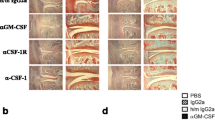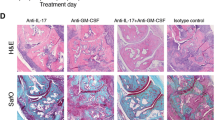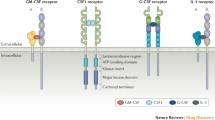Summary
Rheumatoid arthritis is characterised by infiltration of activated immunocompetent cells into synovial tissues. Activated macrophages, secreting proinflammatory cytokines, are found in rheumatoid arthritis synovitis in the presence of memory T cells, which are apparently not producing detectable quantities of those cytokines usually associated with monocyte activation.
Colony-stimulating factors (CSFs) can induce many of the features seen in rheumatoid arthritis synovitis, including monocyte activation, and may be involved in overproduction of macrophage-derived cytokines. The histological localisation of CSFs can help the understanding of their actions in the context of the pathology of the disease. Interactions between CSFs and their receptors on monocytes could at least implicate granulocyte-macrophage CSF in the pathophysiology of rheumatoid arthritis, thereby representing a potential target for novel forms of therapy in this chronic inflammatory disease.
Similar content being viewed by others
References
Garrod A. The nature of gout and rheumatoid gout. London: Walton and Maberley, 1859
Firestein G, Xu W, Townsend K, et al. Cytokines in chronic inflammatory arthritis. I. Failure to detect T cell lymphokines (IL-2 and IL-3) and presence of macrophage colony stimulating factor (CSF-1) and a novel mast cell growth factor in rheumatoid synovitis. J Exp Med 1988; 168: 1573–86
Duke O, Panayi GS, Janossy G, et al. An immunohistochemical analysis of lymphocyte subpopulations and their microenvironment in the synovial membrane of patients with rheumatoid arthritis using monoclonal antibodies. Clin Exp Immunol 1982; 49: 22–30
Burmester G, Jahn B, Rohwer P, et al. Differential expression of Ia antigens by rheumatoid synovial lining cells. J Clin Invest 1987; 80: 595–604
El-Gabalawy H, Gallatin M, Vazeux R, et al. Expression of ICAM-R (ICAM-3), a novel counter receptor for LFA-1 in rheumatoid synovium and non-rheumatoid synovium. Arthritis Rheum 1994; 37: 846–54
Hale L, Martin M, McCollum D, et al. Immunohistochemical analysis of the distribution of cell adhesion molecules within the inflammatory synovial microenvironment. Arthritis Rheum 1989; 32: 22–30
Kidd B, Moore K, Walters M, et al. Immunohistological features of synovitis in ankylosing spondylitis: a comparison with rheumatoid arthritis. Ann Rheum Dis 1989; 48: 92–8
Deleuran BW, Chu CQ, Field M, et al. Localization of interleukin-1α, type 1 interleukin-1 receptor and interleukin-1 receptor antagonist in the synovial membrane and cartilage/pannus junction in rheumatoid arthritis. Br J Rheumatol 1991; 31: 801–9
Chu C, Field M, Feldmann M, et al. Localisation of tumour necrosis factor alpha in synovial tissue and at the cartilage/pannus junction in rheumatoid arthritis. Arthritis Rheum 1991; 34: 1125–32
Field M, Chu C, Feldmann M, et al. Interleukin-6 localisation in rheumatoid arthritis synovial membrane. Rheum Int 1991; 11: 45–50
Firestein G, Zvaifler N. Peripheral blood and synovial fluid monocyte activation in inflammatory synovitis. II. Low levels of synovial fluid and synovial tissue interferon suggest that γ-interferon is not the primary macrophage activating factor. Arthritis Rheum 1987; 30: 864–71
Saxne T, Palladino M, Heingard D, et al. Detection of TNFγ but not TNFβ in rheumatoid arthritis synovial fluid and serum. Arthritis Rheum 1988; 31: 1041–5
Buchan G, Barrett K, Turner M, et al. Detection of activated T cell products in the rheumatoid joint using cDNA probes to interleukin-2, IL-2 receptor and interferon γ. Clin Exp Immunol 1988; 71: 295–301
Moissec P, Naviliat M, D’Angeac D, et al. Low levels of IL-4 and high levels of TGFβ in rheumatoid synovitis. Arthritis Rheum 1990; 33: 1180–7
Brennan FM, Field M, Chu CQ, et al. Cytokine expression in rheumatoid arthritis. Br J Rheumatol 1991; 30 Suppl. 2: 76–80
Farrar M, Schreiber R. The molecular biology of interferon γ and its receptor. Annu Rev Immunol 1994; 11: 571–612
Fischer HG, Frosch S, Reske K, et al. Granulocyte macrophage colony stimulating factor activates macrophages derived from bone marrow cultures to synthesis of MHC Class II molecules and to augment antigen presentation function. J Immunol 1988; 141: 3882–8
Williamson DJ, Begley CG, Vadas MA, et al. The detection and initial characterisation of colony stimulating factors in synovial fluid. Clin Exp Immunol 1988; 72: 67–73
Alvaro-Garcia JM, Zwaifler NJ, Brown CB, et al. Cytokines in chronic inflammatory arthritis. VI. Analysis of the synovial cells in granulocyte macrophage colony stimulating factor production and gene expression in rheumatoid arthritis and its regulation by IL-1 and TNFα. J Immunol 1991; 146: 3365–71
Alvaro-Gracia JM, Zwaifler NJ, Firestein G. Cytokines in chronic inflammatory arthritis. IV. Granulocyte macrophage colony stimulating factor mediated induction of class II antigen on human monocytes: a possible role in rheumatoid arthritis. J Exp Med 1989; 170: 865–75
Gamble JR, Elliot MJ, Jaipargas E, et al. Regulation of human monocyte adherence by granulocyte macrophage colony stimulating factor. Proc Natl Acad Sci USA 1989; 86: 7169–73
De Vreis E, Willemse P, Beisma B, et al. Flare up of rheumatoid arthritis during granulocyte macrophage colony stimulating factor treatment after chemotherapy. Lancet 1991; 338: 517–8
Hazenberg B, Van Leeuwen M, Van Rijswijk M, et al. Correction of granulocytopaenia of Felty’s syndrome by granulocyte macrophage colony stimulating factor: simultaneous induction of interleukin 6 release and flare up of the arthritis. Blood 1989; 74: 2769–70
Williamson DJ, Begley CG, Vadas MA, et al. The detection and initial characterisation of colony stimulating factors in synovial fluid. Clin Exp Immunol 1988; 72: 67–73
Schibler K, Leichty K, White W, et al. Production of granulocyte colony stimulating factor in vitro by monocytes from preterm and term neonates. Blood 1993; 82: 2478–84
Spiekermann K, Emmendoerffer A, Eisner J, et al. Altered surface marker expression and function of G-CSF induced neutrophils from test subjects and patients under chemotherapy. Br J Haematol 1994; 87: 31–8
Yuo A, Kitagawa S, Ohsaka A, et al. Recombinant human granulocyte colony stimulating factor as an activator of human granulocytes: potentiation of responses triggered by receptor mediated agonists and stimulation of C3bi receptor expression and adherence. Blood 1989; 74: 2144–9
Repp R, Valerius T, Sendler A, et al. Neutrophils express the high affinity receptor for IgG (Fc γR1, CD64) after in vivo application of granulocyte colony stimulating factor. Blood 1991; 78: 885–9
Weisbart RH, Golde DW, Clark SC, et al. Human granulocyte macrophage colony stimulating factor is a neutrophil activator. Nature 1985; 314: 361–3
Lindemann A, Herrmann F, Oster W, et al. Haematologic effects of recombinant human granulocyte colony stimulating factor in patients with malignancy. Blood 1989; 74: 2644–51
Leische G, Burgess A. Granulocyte colony stimulating factor and granulocyte macrophage colony stimulating factor. N Engl J Med 1992; 327: 99–106
Lopez A, Williamson J, Gamble J, et al. Recombinant granulocyte macrophage colony stimulating factor stimulates in vitro mature neutrophil and eosinophil functions, surface receptors and survival. J Clin Invest 1986; 78: 1220–8
Pouliot M, McDonald P, Borgeat P, et al. Granulocyte macrophage colony stimulating factor stimulates the expression of the 5-lipoxygenase-activating protein (FLAP) in human neutrophils. J Exp Med 1994; 179: 1225–32
Lindemann A, Reidel D, Oster W, et al. Granulocyte macrophage colony stimulating factor induces cytokine secretion by human polymorphonuclear neutrophils. J Clin Invest 1988; 83: 1308–12
Khwaja A, Johnson B, Addison I, et al. In vivo effects of macrophage colony stimulating factor on human monocyte function. Br J Haematol 1991; 77: 25–31
Sampson-Johannes A, Carlino J. Enhancement of human monocyte tumoricidal activity by recombinant M-CSF. J Immunol 1988; 141: 3680–6
Warren M, Ralph P. Macrophage growth factor CSF-1 stimulates human monocyte production of interferon, tumour necrosis factor and colony stimulating factor. J Immunol 1986; 137: 2281–5
Motoyoshi K, Yoshida K, Hatake K, et al. Recombinant and native urinary colony stimulating factor directly augments granulocyte and granulocyte macrophage colony stimulating factor production by human peripheral blood monocytes. Exp Haematol 1989; 17: 68–71
Feldmann M, Brennan FM, Field M, et al. Pathogenesis of rheumatoid arthritis: cellular and cytokine interactions. In: Smolen JS, Kalden JR, Maini RN, editors. Rheumatoid arthritis. Berlin: Springer Verlag, 1992: 41–54
Brennan F, Chantrey D, Jackson A, et al. Inhibitory effects of TNFα antibodies on synovial cell interleukin-1 production in rheumatoid arthritis. Lancet 1989; 2: 244–7
Keffer J, Probert L, Cazlaris H, et al. Transgenic mice expressing human tumour necrosis factor: a predictive genetic model of arthritis. EMBO J 1991; 10: 4025–31
Elliot MJ, Maini RN, Feldmann M, et al. Randomised double-blind comparison of chimeric monoclonal antibody to tumour necrosis factor α (cA2) versus placebo in rheumatoid arthritis. Lancet 1994; 344: 1105–10
Cannistra SA, Rambaldi A, Spriggs DR, et al. Human granulocyte macrophage colony stimulating factor induces expression of the tumour necrosis factor gene by U937 cell line and normal human monocytes. J Clin Invest 1987; 79: 1720–8
Danis V, Franic G, Rathjen D, et al. Effects of granulocyte macrophage colony stimulating factor (GM-CSF), IL-2, interferon-γ (INF-γ), tumour necrosis factor (TNFα) and IL-6 on the production of immunoreactive IL-1 and TNFα by human monocytes. Clin Exp Immunol 1991; 85: 143–50
Malyak M, Swaney R, Arend W. Levels of synovial fluid interleukin-1 receptor antagonist in rheumatoid arthritis and other arthropathies. Arthritis Rheum 1993; 36: 781–9
Gearing A, Metcalf D, Moore J, et al. Elevated levels of GM-CSF and IL-1 in the serum and pleural cavities of GM-CSF transgenic mice. Immunology 1989; 67: 216–20
Chantrey D, Turner M, Brennan F, et al. Granulocyte macrophage colony stimulating factor induces both HLA DR expression and cytokine production by human monocytes. Cytokine 1990; 2: 60–7
Hart P, Whitty G, Picolli D, et al. Synergistic activation of human monocytes by granulocyte macrophage colony stimulating factor and interferon γ. Increased production of TNFα but not IL-1 activity. J Immunol 1991; 141: 1516–21
Hamilton J, Whitty G, Stanton H, et al. Effects of macrophage colony stimulating factor on human monocytes: induction of expression of urokinase type plasminogen activator, but not secreted prostaglandin E2, IL-6, IL-1 or TNFα. J Leukoc Biol 1993; 53: 707–14
Haworth C, Brennan F, Chantrey D, et al. Expression of granulocyte macrophage colony stimulating factor in rheumatoid arthritis: regulation by tumour necrosis factor [abstract]. Eur J Immunol 1991; 21: 2575–9
Chu CC, Field M, Allard SA, et al. Detection of cytokines at the cartilage/pannus junction in patients with rheumatoid arthritis: implications for the role of cytokines in cartilage destruction and repair. Br J Rheumatol 1992; 31: 653–61
Field M, Clinton L. Granulocyte macrophage colony stimulating factor in rheumatoid arthritis. Clin Rheumatol 1994; 13: 178
Kaushansky K. Control of granulocyte macrophage colony stimulating factor in normal endothelial cells by positive and negative regulatory elements. J Immunol 1989; 143: 2525–9
Zsebo K, Yushenkoff V, Schiffer S, et al. Vascular endotheial cells and granulopoiesis: interleukin-1 stimulates release of G-CSF and GM-CSF. Blood 1988; 71: 99–103
Field M, Clinton L. Expression of GM-CSF receptor in rheumatoid arthritis. Lancet 1993; 342: 1244
Gliniak B, Rohrschneider L. Expression of the M-CSF receptor is controlled post-transcriptionally by the dominant actions of GM-CSF or multi-CSF. Cell 1990; 63: 1073–83
Day R. Slow acting anti-rheumatic drugs I. In: Klippel JH, Dieppe PA, editors. Rheumatology. London: Mosby Year Book Europe, 1994: 8.12.1–10
Furst D, Clements P. Slow acting anti-rheumtic drugs II. In: Klippel JH, Dieppe PA, editors. Rheumatology. London: Mosby Year Book Europe, 1994: 8.13.1–8
Hamilton J, Williams N. In vitro inhibition of myelopoiesis by gold salts and D-penicillamine. J Rheumatol 1985; 12: 892–6
Yanni G, Farahat M, Poston R, et al. Cytokine expression in rheumatoid arthritis synovial membrane following treatment with intramuscular gold. Arthritis Rheum 1992; 35 Suppl. 9: S108
Matsubara T, Ziff M. Inhibition of human endothelial cell proliferation by gold compounds. J Clin Invest 1987; 79: 1440–46
Madhok R, Wijelath E, Smith J, et al. Is the beneficial effect of sulphasalazine due to inhibition of synovial neovascularisation? J Rheumatol 1991; 18: 199–202
Hamilton J. Rheumatoid arthritis: opposing actions of haemopoietic growth factors and slow acting anti-rheumatic drugs. Lancet 1993; 342: 536–9
Author information
Authors and Affiliations
Rights and permissions
About this article
Cite this article
Field, M. Colony-Stimulating Factors. Clin. Immunother. 3, 255–261 (1995). https://doi.org/10.1007/BF03259277
Published:
Issue Date:
DOI: https://doi.org/10.1007/BF03259277




